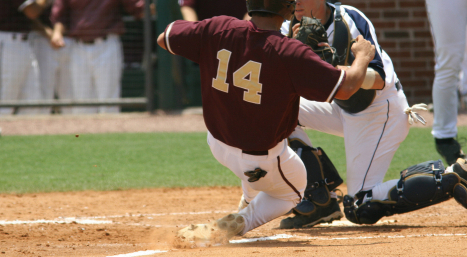The Situation:
It’s the bottom of the 9th inning in a game that has seen a lot of offense. The teams have combined for 29 hits and the home team is trailing 12-10. There is a runner on third and two outs for the 2-hole hitter. The defense is trying to hold on for the win, and has already given up 2 runs this inning. The left-handed batter steps in against the right-handed side-arm closer.
The Play:
The pitcher toes the rubber, gets his sign, comes set, and delivers. He holds onto the ball too long and uncorks a wild pitch that the catcher can’t even get his glove on. The hitter jumps back out of the way as the ball narrowly misses his jersey. The ball sails to the backstop and the runner from third breaks for home without hesitation. The ball hits the backstop padding with a thud and ricochets hard back towards the plate.
The Outcome:
The pitcher and runner converge on home plate as the catcher turns, takes a few steps and fields the ball rolling back to him. With the runner’s good jump at third, the play is close, but everyone on the defense executes their job. The pitcher get to home, the feed is good, the tag is slapped down on the runners foot and he is called out. The game is over with the visitors winning 12-10.
What Went Wrong:
Let’s focus on two things that could have been done differently to change the opportunity the offense has to win the game. The batter jumping out of the way of the pitch instead of taking the dose is one mistake. Had he worn the pitch, it would have put the tying run on first base where a gapper has the potential to tie the game. It also would have prevented the base runner from making the more costly mistake that ends the game.
Even though the runner gets a good jump on the wild pitch and gets an unlucky bounce off of the backstop, his decision to go is a huge mental mistake. There are two outs and the tying run at the plate. Even if he scores on the play, his team will still lose 12-11 unless the batter can come around to score. Since the goal is to win, losing 12-10 or 12-11 makes no difference. Simply put, the runner cannot take any chance of being out. Zero. This can be a hard thing to wrap your mind around when 98% of the time as a base runner you are trying to be aggressive and take advantage of every opportunity to steal 90 feet and score runs.
In this situation, the bigger picture has to take priority over the small, 90 foot victory. It’s another case of understanding who the important run is and giving the team every opportunity to get that most important run home. Had the runner at 3rd reminded himself before the at bat that he only matters if he scores in addition to the batter, he would know that staying at 3rd, even when odds are good to score is the right move. Next time, you can bet the runner will be thinking the game and you can learn from his mistake and do the same.







